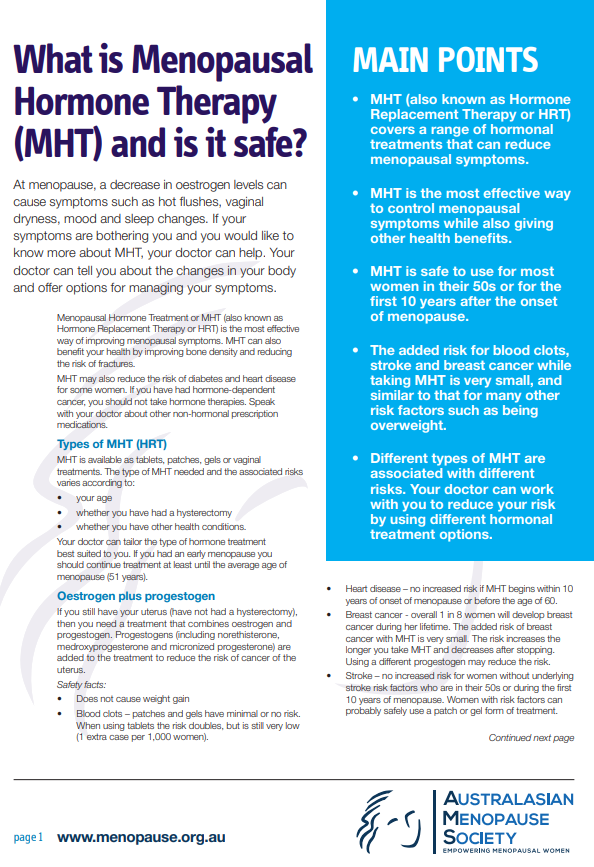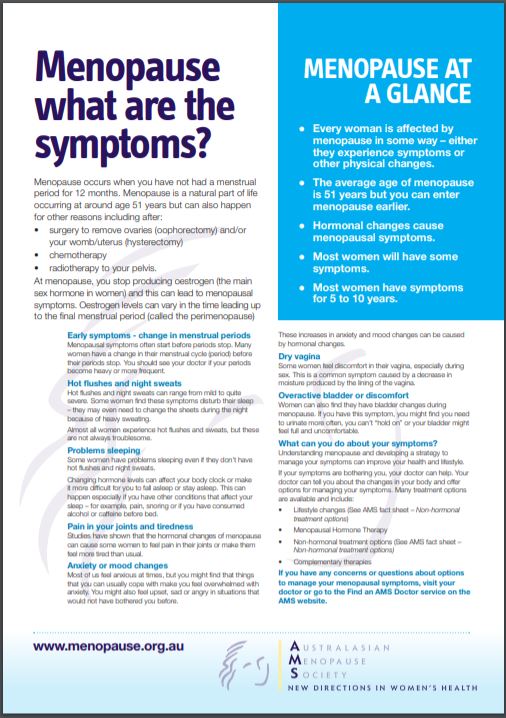MHT contains different hormones – oestrogen, progestogen or both – and it can be taken or used in different ways such as tablets, patches or gel.
The type of MHT needed and any risks varies according to your age, whether you have had an operation to remove your womb or uterus (hysterectomy) and whether you have other health conditions.
If you have menopausal symptoms that affect your quality of life and want to know what treatments could help, talk to your healthcare provider. The following is some guidance.
Oestrogen alone
Oestrogen alone is suitable if you've had an operation where your uterus has been removed (hysterectomy).
Oestrogen is available as different products and in different strengths.
- Tablets such as Progynova, Estrofem, Ovestin, Premarin.
- Patches such as Estradiol, Estradot and Estraderm MX, Lyllana Estradiol.
- Gel such as Estrogel.
Safety considerations of oestrogen alone
- Blood clots: Patches and gel have minimal or no risk. When using tablets, the risk doubles, but it's still very low (1 extra blood clot per 1000 women).
- Heart disease: MHT may decrease the risk of heart disease if started within 10 years of menopause or before the age of 60.
- Breast cancer: Overall 1 in 8 women will develop breast cancer during their lifetime. Studies suggest there's either no increase, or a very small increased risk of breast cancer when using oestrogen only MHT. Breast cancer risk is lower with oestrogen only MHT compared with oestrogen plus progestogen.
- Stroke: There's no increased risk if you don’t already have risk factors for stroke and you're in your 50s or during the first 10 years of menopause. If you have risk factors you can probably still safely use a patch.
Vaginal oestrogen cream or pessaries (Ovestin cream® and Ovestin pessaries®)
If your symptoms are mainly related to vaginal dryness, urinary symptoms and pelvic floor problems, applying oestrogen directly to your vagina may be more suitable.
- It's designed to work mainly in your vagina, bladder and pelvic floor.
- The oestrogen levels in your blood aren't raised significantly, which minimises the effect of oestrogen in other areas such as the breast or uterus.
- Vaginal oestrogen can be used alone or with MHT.
- It doesn't need to be used with any progestogen even if you still have a uterus. There's no increased risk of blood clots, so you don't need to use progesterone. Read more about oestrogen vaginal cream(external link).
Oestrogen plus progestogen
If you still have your uterus, your MHT will include both oestrogen and progestogen. This is because oestrogen alone can overstimulate the cells lining your uterus, causing an increased risk of cancer of the uterus lining. So if you have a uterus you will need to take progestogen together with oestrogen to reduce the risk.
Example of progestogen only products include:
You will need to take these with oestrogen only products. Some products have both oestrogen plus progestogen in a single tablet such as Kliogest, Kliovance and Trisequens.
Safety considerations of oestrogen plus progestogen
- Blood clots: Patches and gel have minimal or no risk. When using tablets the risk doubles, but it's still very low (1 extra blood clot per 1,000 women).
- Heart disease: There's no increased risk if MHT is started within 10 years of the start of menopause or before the age of 60.
- Breast cancer: Overall 1 in 8 women will develop breast cancer during their lifetime. The added risk of breast cancer with MHT is very small. The risk increases the longer you take MHT and decreases after stopping it. Some types of progesterone have lower risk.
- Stroke: There's no increased risk if you don’t already have risk factors and you're in your 50s or during the first 10 years of menopause. If you have risk factors you can probably safely use a patch.
- MHT with oestrogen and progesterone doesn't cause weight gain.
Tibolone (also called Livial)
Tibolone isn’t oestrogen or progesterone, but it has similar effects. Tibolone can be used if you still have your uterus and haven't had a natural period for at least 1 year. It comes as a tablet that's taken once a day.
Note: Tibolone is not funded in Aotearoa New Zealand.
- Tibolone can reduce the risk of osteoporosis (thinning of the bones) in post-menopausal people.
- It doesn't cause an increase in blood clots, heart disease or breast cancer. It reduces breast tenderness and there is no evidence of an increase in breast cancer risk with 3 years of use.
- It increases the risk of stroke if started after the age of 60.
- Read more about tibolone.(external link)









